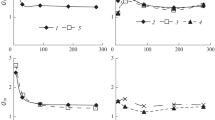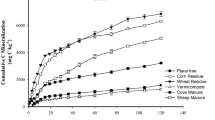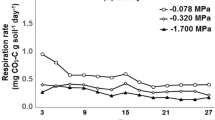Abstract.
A loamy sand was incubated with and without addition of carrot leaves at six different water contents ranging from 6% to 20% (g 100 g–1 dry soil) and N mineralization was monitored during 98 days. We calculated zero- and first-order rates for mineralization in the unamended soil and first-order rates for N mineralization in the residue-amended soil. Although N mineralization was strongly affected by soil moisture, rates were still important at 6% water content (corresponding to permanent wilting point), particularly in the residue-amended soil. Soil water content was recalculated as soil water tension and as percent water-filled pore space (%WFPS) and a parabolic, a logistic and a Gaussian-type function were fitted to the relation between N mineralization rates and water content, %WFPS or pF. Water potential was a less suitable parameter than either %WFPS or water content to describe the soil water influence on N mineralization, because N mineralization rates were extremely sensitive to changes in the water potential in the range of pF values between 1.5 and 2.5. In the residue-amended soil the Gaussian model yielded an optimum %WFPS of 56% for N mineralization, which is slightly lower than optimum values cited in literature. N mineralization in the unamended soil was more influenced by soil water than N mineralization from fresh crop residues. This could be explained by less water limitation of the microbial population decomposing the residues, due to the water content of the residues. The effect of the water contained in the residues was most pronounced in the lowest water content treatments. The water retention curves of both undisturbed and repacked soil were determined and suggested that extrapolation of results obtained during laboratory incubations, using disturbed soil, to field conditions will be difficult unless soil bulk density effects are accounted for, as is the case with the use of %WFPS.
Similar content being viewed by others
Author information
Authors and Affiliations
Additional information
Electronic Publication
Rights and permissions
About this article
Cite this article
De Neve, S., Hofman, G. Quantifying soil water effects on nitrogen mineralization from soil organic matter and from fresh crop residues. Biol Fertil Soils 35, 379–386 (2002). https://doi.org/10.1007/s00374-002-0483-3
Received:
Accepted:
Issue Date:
DOI: https://doi.org/10.1007/s00374-002-0483-3




